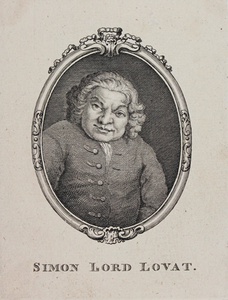| Method | Copper engraving |
| Artist | after William Hogarth |
| Published | [London, 1757] |
| Dimensions | Image 90 x 67 mm, Sheet 128 x 98 mm |
| Notes |
A half length portrait of Simon Lord Lovat after Hogarth in an oval from Smollett's History of England. Simon Fraser, 11th Lord Lovat (c.1667-1747), was a Scottish Jacobite and Chief of Clan Fraser. He was famous for his violent feuding and his changes of allegiance. In 1715, he had been a supporter of the House of Hanover, but in 1745 he changed sides and supported the Stuart claim to the crown of the United Kingdom. Lovat was among the Highlanders defeated at the Battle of Culloden. He was convicted of treason, and was the last man in Britain to be publicly beheaded, at Tower Hill, London. O'Donoghue 9 Ex. Col.: Earl de Grey Condition: Trimmed to the plate mark and tipped to an album sheet, Earl de Grey's collection mark stamped on verso. |
| Framing | unmounted |
| Price | £35.00 |
| Stock ID | 44574 |

